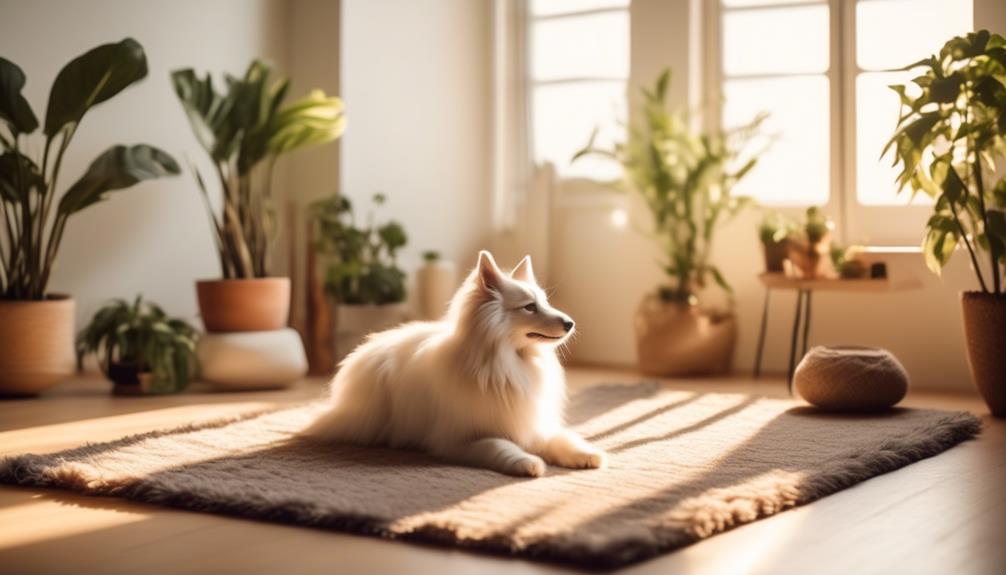Do Pets Really Benefit From Yoga Practices?

Pets can benefit from yoga practices by improving their overall health and happiness. According to a growing body of evidence.
Key Takeaways
- Pet yoga has numerous physical benefits, including improved coordination, body awareness, cardiovascular health, flexibility, and reduced risk of musculoskeletal issues.
- Engaging in interactive play, training sessions, quality time, and outdoor adventures helps enhance the bond between pets and their owners, building trust and communication.
- Yoga provides stress relief for pets by reducing stress levels, promoting relaxation and calmness, and improving flexibility and bonding between pet and owner.
- Pet owners can use calming techniques such as pet massage, aromatherapy, music therapy, mindfulness exercises, and creating a peaceful environment to help their pets relax.
The Physical Benefits of Pet Yoga
Pet yoga offers numerous physical benefits for both humans and their furry companions. One of the main benefits is the improvement in coordination in pets. By engaging in various yoga poses, pets are required to move their bodies in different ways, which helps to enhance their coordination skills. This is particularly beneficial for pets that may have limited mobility or struggle with balance.
Additionally, pet yoga helps to increase body awareness in pets. Through the practice of yoga, pets become more attuned to their own bodies and develop a better understanding of their physical capabilities. This increased body awareness allows them to move more efficiently and effectively, reducing the risk of injury and improving overall physical functioning.
Research has shown that pet yoga can also have positive effects on pets' cardiovascular health. The gentle stretching and movement involved in yoga help to improve circulation, which in turn can contribute to better heart health. Furthermore, pet yoga has been found to promote flexibility and joint mobility, which can help to prevent stiffness and reduce the risk of musculoskeletal issues.
Enhancing the Bond Between You and Your Pet

Building a strong bond with your furry companion isn't only important for their overall well-being, but it can also have numerous benefits for both you and your pet. Engaging in bonding activities and exercises can deepen your connection and create a harmonious relationship.
Here are four evidence-based ways to enhance the bond between you and your pet:
- Interactive play: Regular play sessions with your pet can strengthen your bond by promoting trust and communication. Use toys or engage in games that encourage physical activity and mental stimulation. This shared experience can create positive associations and build a foundation of trust between you and your pet.
- Training sessions: Participating in training exercises with your pet not only teaches them important skills, but it also fosters a sense of teamwork and mutual understanding. Positive reinforcement techniques, such as rewards and praise, can reinforce desired behaviors and strengthen the bond between you and your pet.
- Quality time: Dedicate regular, uninterrupted time to spend with your pet. This can include cuddling, grooming, or simply being present with them. This focused attention helps your pet feel loved and valued, deepening the emotional connection between you both.
- Outdoor adventures: Exploring the outdoors together can provide new experiences and strengthen your bond. Whether it's going for a walk, hiking, or visiting a pet-friendly park, these shared adventures create lasting memories and deepen the bond between you and your pet.
Stress Relief for Pets Through Yoga

Stress can affect our furry friends just as it does humans, and finding ways to help them relax and unwind is essential for their overall well-being.
Through the practice of pet yoga, also known as doga, calming techniques such as gentle stretching, breathing exercises, and massage can be employed to reduce stress levels in pets.
Not only does pet yoga provide an opportunity for relaxation, but it also offers numerous benefits, including improved flexibility, increased bonding between pet and owner, and enhanced physical and mental health for the pet.
Calming Techniques for Pets
Using gentle and mindful movements, yoga offers effective techniques to help pets find relief from stress and anxiety. Along with yoga, there are other calming techniques that can be used to support our furry friends.
These techniques include:
- Pet massage: Just like humans, pets can benefit from the soothing touch of a massage. Gentle strokes and kneading can help relax their muscles and stimulate the release of endorphins, promoting a sense of calm.
- Aromatherapy for pets: Certain scents, such as lavender or chamomile, have been shown to have a calming effect on animals. Using essential oils in a diffuser or diluted in water can help create a peaceful environment for your pet.
- Music therapy: Playing soft and calming music can help create a relaxing atmosphere for your pet. Studies have shown that classical music, in particular, can help reduce stress levels in animals.
- Mindfulness exercises: Practicing mindfulness with your pet can help both of you find inner peace. By focusing on the present moment and engaging in activities such as deep breathing or guided meditation, you can help your pet feel more grounded and centered.
Benefits of Pet Yoga
Yoga offers a multitude of benefits for pets, providing them with a natural and effective way to relieve stress and promote overall well-being. Just as humans can benefit from yoga, pets can also experience the positive effects of this ancient practice.
One of the key advantages of pet yoga is its ability to serve as a form of physical therapy for pets. Through gentle stretches and movements, yoga can help improve flexibility, range of motion, and muscle strength in animals. Additionally, pet yoga serves as an alternative exercise for pets who may have limitations or restrictions due to age, injury, or medical conditions.
Improving Flexibility and Agility in Pets

Improving the flexibility and agility of pets can be achieved through targeted exercises and training techniques. By incorporating these practices into their daily routine, pet owners can help their furry companions enhance their balance, prevent injuries, and ultimately lead healthier lives.
Here are four evidence-based techniques to improve flexibility and agility in pets:
- Stretching exercises: Regular stretching helps increase muscle flexibility and joint range of motion in pets. It can also improve their balance and coordination.
- Balance training: Engaging in activities that challenge a pet's balance, such as walking on uneven surfaces or using balance boards, can enhance their proprioception and overall stability.
- Agility courses: Training pets through agility courses not only promotes physical fitness but also sharpens their reflexes and improves their ability to navigate obstacles.
- Core strengthening exercises: Strengthening the core muscles in pets, such as the abdominal and back muscles, can improve their overall stability and prevent injuries.
Promoting Mindfulness and Calmness in Pets

Promoting mindfulness and calmness in pets can have numerous benefits for their overall well-being. Research has shown that incorporating yoga practices into a pet's routine can help reduce stress and anxiety, improve focus and concentration, and enhance their ability to relax.
Techniques such as gentle stretching, deep breathing exercises, and guided meditation can be utilized to create a peaceful and tranquil environment for pets, fostering a sense of mindfulness and calmness.
Benefits of Pet Yoga
Practicing yoga with pets can contribute to their overall well-being by nurturing a sense of mindfulness and tranquility. Pet yoga, also known as 'doga,' has been shown to provide numerous benefits for pets, improving their health and increasing their happiness.
Here are four ways in which pet yoga can positively impact your furry friend:
- Reduces stress: Just like humans, pets can experience stress and anxiety. Pet yoga helps them relax, release tension, and find inner peace.
- Enhances flexibility and strength: Regular yoga sessions can improve your pet's flexibility and strengthen their muscles, promoting better mobility and overall physical health.
- Deepens the human-pet bond: Engaging in yoga together creates a unique bonding experience, deepening the connection between you and your pet.
- Promotes mental stimulation: The focus and concentration required in yoga help stimulate your pet's mind, keeping them mentally sharp and engaged.
Techniques for Pet Relaxation
To help pets achieve a state of mindfulness and calmness, various techniques can be employed. One effective technique is pet massage. Similar to human massage therapy, pet massage involves gentle strokes and kneading to relax the muscles and promote circulation. This can help pets release tension and reduce anxiety.
Another technique is meditation for pets. Just as humans benefit from meditation, pets can also experience a sense of calmness and relaxation through guided meditation. This involves creating a quiet and peaceful environment, playing soft music, and guiding the pet through deep breathing exercises.
Regular practice of pet massage and meditation can help pets develop a sense of mindfulness, reduce stress, and promote overall well-being. It's important to consult with a professional or veterinarian to ensure the techniques are performed safely and effectively.
Boosting Mental Stimulation and Focus in Pets

Engaging in yoga practices can enhance the mental stimulation and focus of pets. Just like humans, pets can benefit from the mindfulness and concentration that yoga brings. Here are four ways that incorporating yoga into daily pet routines can boost mental stimulation and focus:
- Increased mindfulness: Through yoga, pets learn to be present in the moment and focus on their breath and movements. This helps improve their overall mindfulness, allowing them to be more attentive and focused in other aspects of their lives.
- Mental exercise: Yoga poses require pets to engage their minds and bodies simultaneously. This mental exercise helps improve their cognitive function and problem-solving skills, keeping their minds sharp and active.
- Stress reduction: Yoga promotes relaxation and reduces stress in pets, allowing them to let go of anxiety and distractions. This helps them concentrate better and stay focused on tasks or training sessions.
- Bonding and socialization: Practicing yoga with pets creates a special bond and strengthens the human-animal relationship. This increased connection and socialization can improve a pet's mental well-being and ability to focus.
Creating a Positive and Relaxing Environment for Pets

Creating a positive and relaxing environment for pets is crucial for their overall well-being and mental health. Just like humans, pets benefit from having a peaceful and secure space where they can feel safe and at ease. This environment can be created in various ways, ensuring that the needs and preferences of the individual pet are met.
One important aspect of creating a peaceful environment is providing a designated space for the pet. This can be a specific room, corner, or even a cozy bed where they can retreat to when they want some alone time. This space should be comfortable, quiet, and free from any potential stressors or disturbances.
In addition to a designated space, creating a sense of security is essential. This can be achieved by establishing a consistent routine for feeding, exercise, and playtime. Pets thrive on predictability and structure, so having a daily schedule can help them feel secure and reduce anxiety.
Another element of a positive environment is ensuring that the pet's physical and emotional needs are met. This includes providing a balanced diet, engaging in regular exercise and mental stimulation, and offering plenty of love, attention, and affection.
Frequently Asked Questions
How Long Does It Take for Pets to See the Physical Benefits of Practicing Yoga?
Pets can see physical benefits from practicing yoga, but the time it takes varies. Elderly pets may benefit from the gentle movements and stretching, improving flexibility and joint health. Introducing pets gradually to yoga can help them adapt and enjoy the practice.
Are There Any Specific Yoga Poses That Should Be Avoided When Practicing With Pets?
When practicing yoga with pets, it is important to avoid poses that may put strain on their bodies, such as headstands or deep twists. Instead, focus on gentle stretches and poses that promote relaxation and bonding.
Can Pets of All Ages and Breeds Participate in Yoga Practices?
Pets of all ages and breeds can benefit from yoga practices. It helps senior pets improve flexibility, balance, and joint health. Different dog breeds can also benefit from specific poses that target their unique needs.
Are There Any Potential Risks or Side Effects Associated With Pet Yoga?
There may be potential risks or side effects associated with pet yoga, but it is important to note that these can be minimized with proper guidance and precautions.
Can Pet Yoga Be Used as a Form of Therapy for Pets With Anxiety or Behavioral Issues?
Pet yoga can be used as a form of therapy for pets with anxiety or behavioral issues. It can help reduce separation anxiety and improve pet owner bonding. However, more research is needed to fully understand its impact.









